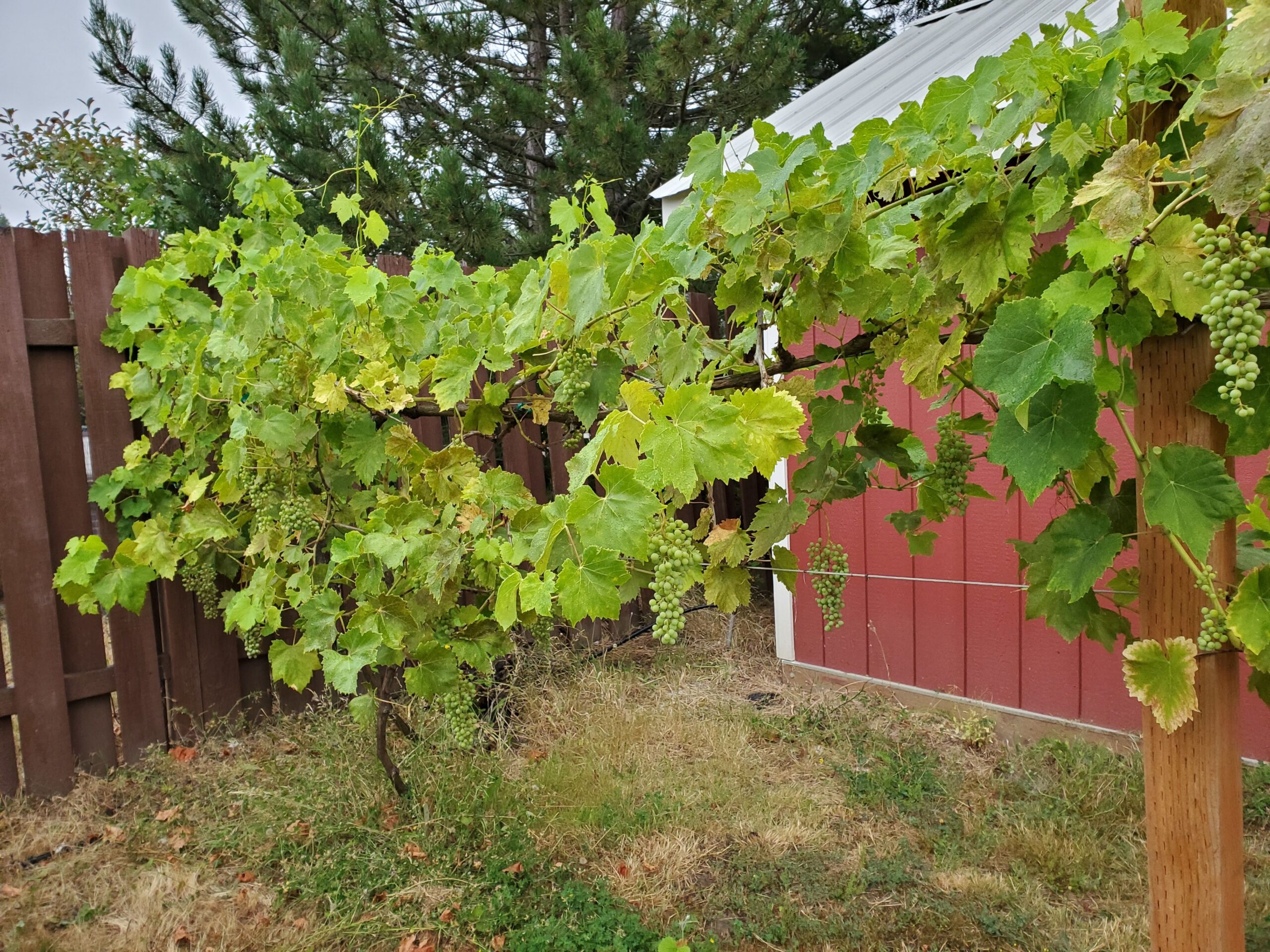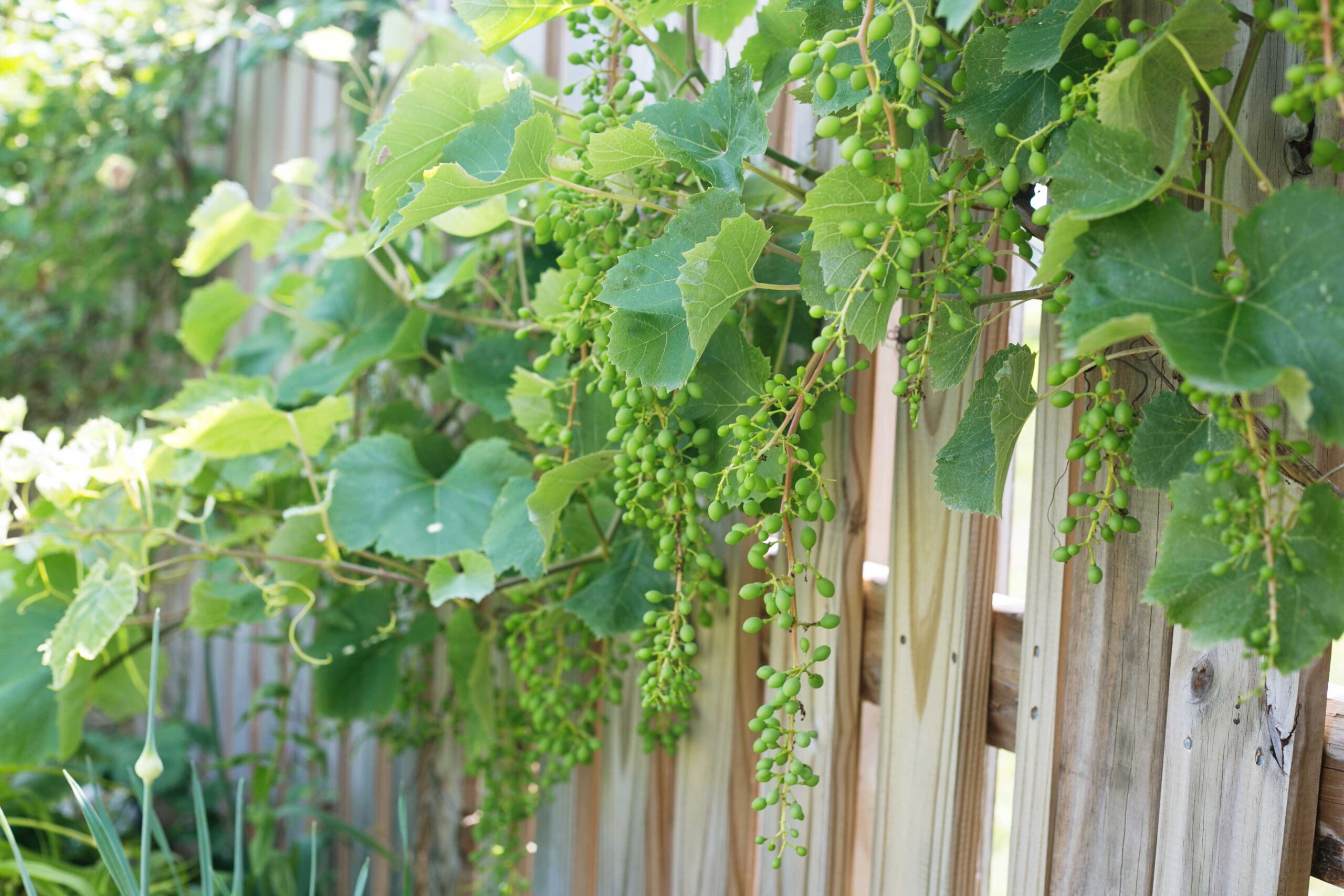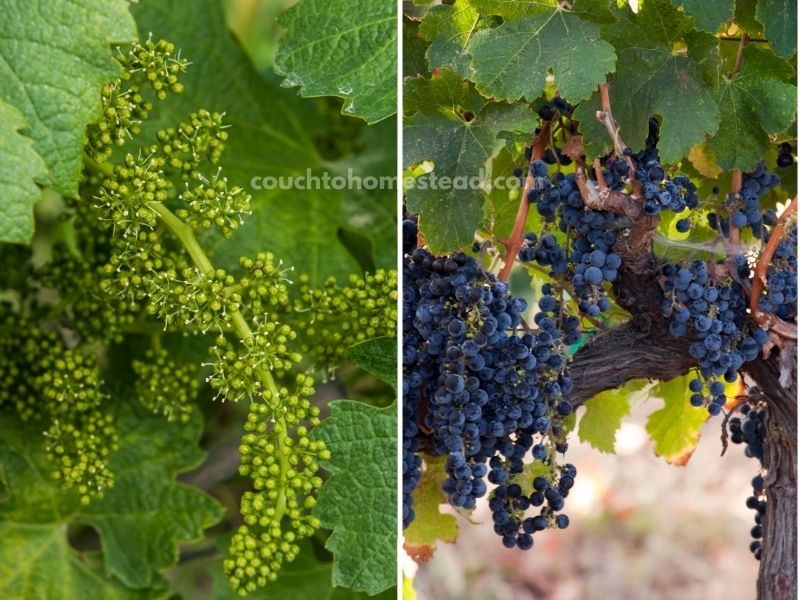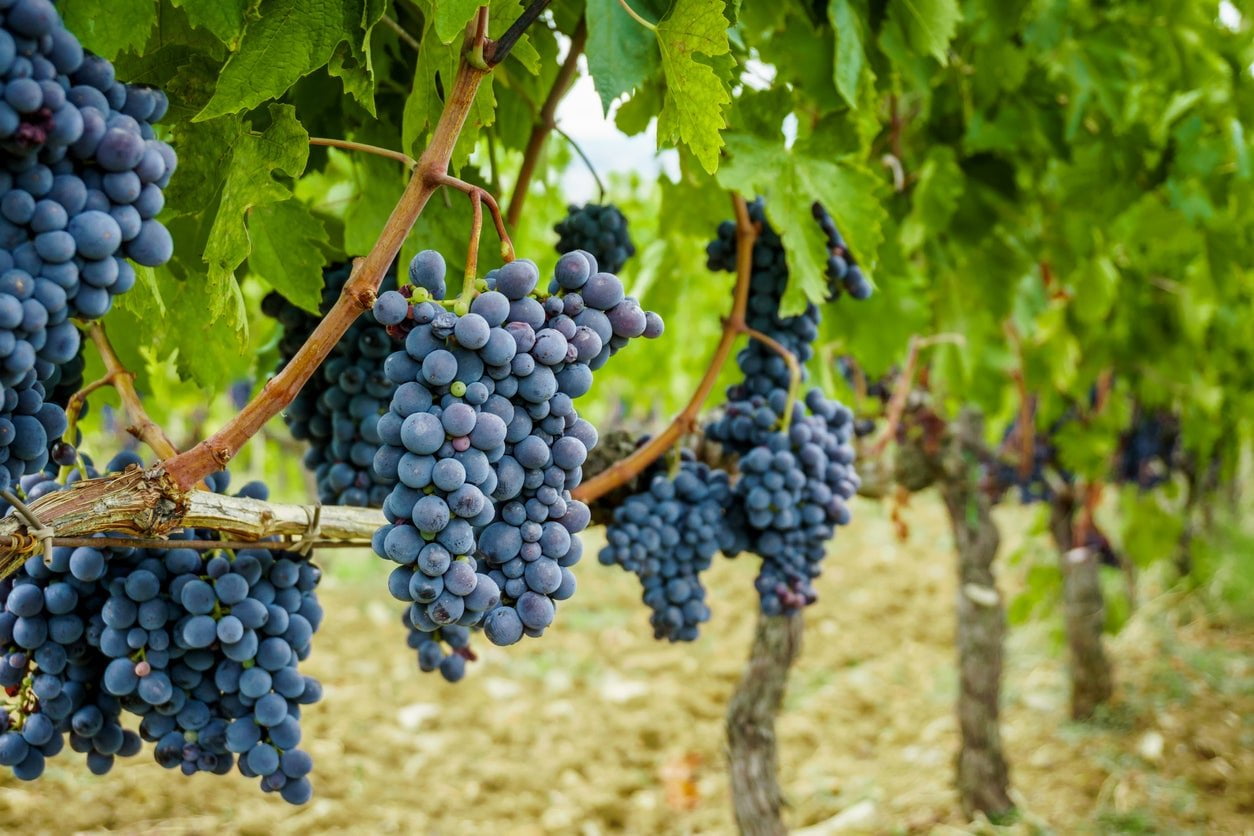Are you a grape vine enthusiast who is frustrated by the lack of grapes on your vine? If so, you may be wondering why your grape vine is not producing the desired fruit. Several factors can contribute to this issue, ranging from improper pruning techniques to insufficient sunlight or nutrient deficiencies. In this article, we will explore the common reasons why grape vines fail to produce grapes and provide practical solutions to help you maximize your vine’s fruit production. By understanding and addressing these factors, you will be well on your way to enjoying a bountiful harvest of delicious grapes from your vine.

Possible Reasons for Lack of Grape Production
Grape vines are known for their abundant production of delicious fruits, but there can be various factors that contribute to a lack of grape production. It is important to identify and address these issues in order to ensure a fruitful harvest. Here are the possible reasons for the lack of grape production:
Insufficient Sunlight
Sunlight plays a crucial role in the growth and development of grapevines. These plants require ample sunlight to produce energy through photosynthesis, which is essential for grape production. Insufficient sunlight can hinder the vine’s ability to photosynthesize and subsequently result in poor fruiting.
Poor Soil Conditions
The soil in which grapevines are planted plays a crucial role in their overall health and productivity. If the soil conditions are poor, the vines may struggle to absorb essential nutrients and water, leading to stunted growth and limited fruit production. It is important to address any soil issues that may be present in order to promote healthy grapevine growth.
Improper Pruning
Pruning is a vital aspect of grapevine cultivation as it helps maintain proper vine structure, promotes airflow, and encourages fruit production. Improper pruning techniques can disrupt the natural growth pattern of the vines, resulting in reduced grape production. It is essential to understand the correct pruning methods and timing to optimize grape production.
Lack of Pollination
Pollination is a critical process for the production of fruits in grapevines. Without proper pollination, grapevine flowers may not turn into fruits. There can be various factors contributing to the lack of pollination, including the absence of pollinators or inadequate pollinator activity. Understanding the pollination process and implementing appropriate pollination methods can help improve grape production.
Inadequate Watering
Water is essential for the growth and development of grapevines, and inadequate watering can significantly impact grape production. Insufficient water supply can lead to water stress, affecting the vine’s ability to produce healthy fruits. Understanding the watering requirements of grapevines and implementing proper irrigation techniques is crucial for optimizing grape production.
Disease or Pest Infestation
Grapevines are susceptible to various diseases and pests that can severely impact their productivity. Common grapevine diseases, such as powdery mildew, downy mildew, and botrytis, can weaken the vines and reduce fruit production. Additionally, pests like grape phylloxera and mealybugs can cause significant damage to grapevines. Preventive measures and integrated pest management strategies are essential for controlling diseases and pests and promoting grape production.
Improper Vine Age or Health
The age and health of grapevines have a direct impact on their ability to produce grapes. Young vines may take several years to mature and start fruit production, while old vines may experience reduced productivity due to declining vigor. Ensuring that vines are of optimal age and maintaining their health through appropriate vineyard management practices is crucial for maximizing grape production.
Environmental Factors
Environmental factors such as climate, frost, extreme heat, wind, and hail can all affect grape production. Grapevines have specific climate requirements, and deviations from these ideal conditions can adversely impact their growth and fruiting. Frost, extreme heat, wind damage, and hail damage can cause direct harm to the vines and hinder grape production.
Improper Training or Trellising
Proper training and trellising of grapevines are essential for their optimal growth and fruit production. Improper training techniques or inadequate trellis systems can prevent vines from accessing sufficient sunlight, airflow, and nutrients, leading to limited grape production. Implementing appropriate training and trellising methods can help overcome these challenges.
Varietal Factors
Different grape varieties have varying adaptability and specific requirements for optimal fruit production. Some varieties may be more suitable for certain climates or soil conditions, while others may have specific needs for pollination or pruning. Understanding the characteristics and requirements of different grape varieties can help address specific varietal factors that may impact grape production.
Insufficient Sunlight
Importance of Sunlight for Grapevines
Sunlight is of utmost importance for grapevines as it provides the energy needed for photosynthesis, the process by which plants convert sunlight into sugars and other essential nutrients. Grapevines require a minimum of six hours of direct sunlight per day for optimal growth and fruit production. Sunlight not only fuels the vine’s growth but also helps develop the flavors, colors, and sugars in the grapes, enhancing their overall quality.
Effects of Shade on Grape Production
Insufficient sunlight due to shade can have detrimental effects on grape production. Shade can reduce the vine’s ability to photosynthesize, leading to limited energy production and reduced fruiting. Inadequate sunlight can also result in poor fruit set, smaller berry size, and underdeveloped flavors in the grapes. It is crucial to ensure that grapevines are planted in locations where they receive sufficient sunlight throughout the day to promote optimal grape production.

Poor Soil Conditions
Role of Soil in Grape Development
The soil in which grapevines are planted plays a vital role in their overall development and productivity. The soil acts as a medium to anchor the vine’s roots and provides essential nutrients and water necessary for growth. Additionally, soil composition, structure, and fertility influence the vine’s ability to take up and utilize these nutrients, ultimately affecting grape production.
Common Soil Issues
Several soil issues can hinder grapevine growth and fruit production. Compacted soil restricts root growth and reduces water and nutrient absorption. Poor drainage can lead to waterlogged conditions, causing root suffocation. Soil pH imbalance can limit nutrient availability to the vines. Excessive salinity can negatively impact grapevines’ ability to absorb water and nutrients. Identifying and addressing these common soil issues is crucial for optimizing grape production.
Testing and Improving Soil
Regular soil testing is essential for evaluating its composition and identifying any deficiencies or imbalances. Soil tests provide valuable information about pH levels, nutrient content, and potential issues that may be affecting grapevine health and productivity. Based on the test results, soil amendments can be applied to improve soil fertility, drainage, or pH, ensuring an optimal environment for grapevine growth and fruit production.
Nutrient Deficiencies
Nutrient deficiencies in the soil can severely impact grape production. Essential nutrients like nitrogen, phosphorus, potassium, calcium, and magnesium are crucial for vine health and fruit development. Deficiencies in these nutrients can lead to stunted growth, nutrient imbalances, poor fruit set, and reduced grape quality. It is important to monitor soil nutrient levels and provide appropriate fertilization to address any deficiencies and promote healthy grape production.
Improper Pruning
Importance of Pruning
Pruning is a fundamental practice in grapevine cultivation that involves removing certain parts of the vine to control growth, maintain appropriate canopy shape, and promote fruiting. Proper pruning is essential for optimizing grape production as it ensures the vine’s resources are allocated efficiently, resulting in healthy growth, improved airflow, and increased fruit quality.
Wrong Pruning Techniques
Improper pruning techniques can have negative consequences on grape production. Over-pruning, removing excessive amounts of cane or spur, can result in reduced fruiting wood and lower grape yield. Under-pruning, on the other hand, can lead to excessive vegetative growth at the expense of fruit production. It is crucial to understand the correct pruning techniques specific to the grape variety being grown and implement them accordingly.
Timing of Pruning
The timing of pruning is critical for achieving the desired results in grape production. Pruning during the dormant season, before the buds break, is common practice as it allows for better visibility of the vine structure and minimizes the risk of disease transmission. Pruning too early or too late in the dormant season can impact bud development and subsequent fruit set. Careful consideration of the grape variety, local climate, and growth patterns is necessary when determining the appropriate timing for pruning.
Overpruning or Underpruning
Overpruning or underpruning can both result in reduced grape production. Overpruning, where too much vegetative growth is removed, can limit the number of fruiting buds and subsequently decrease grape yield. Underpruning, on the other hand, can lead to excessive vegetative growth and fewer fruiting canes. Striking the right balance in pruning, based on the vine’s vigor, variety, and desired grape yield, is crucial for maximizing grape production.

Lack of Pollination
Understanding the Pollination Process
Pollination is an essential process for the production of grapes in grapevines. It occurs when pollen is transferred from the male part of a flower (anther) to the female part (stigma) of the same or a different flower, resulting in fertilization. This fertilization process stimulates the development of seeds and subsequent fruit formation.
Absence or Inadequate Pollinators
The lack of adequate pollinators can significantly impact grape production. Many grapevines rely on pollinators such as bees, butterflies, and other insects to transfer pollen between flowers. If pollinators are absent or insufficient in number, there may be limited pollen transfer, resulting in poor fruit set and reduced grape production. Creating favorable habitats for pollinators and ensuring a diverse range of flowering plants nearby can help increase pollinator activity and improve grape production.
Hand Pollination Methods
In situations where natural pollination may be inadequate, hand pollination can be employed as a solution to improve grape production. This involves manually transferring pollen from the anthers to the stigmas using a small brush or cotton swab. Hand pollination allows for greater control over the pollination process and ensures better fruit set and increased grape yield. It can be a labor-intensive process but is useful in situations where pollinators are scarce or unreliable.
Inadequate Watering
Importance of Proper Watering
Proper watering is crucial for the health and productivity of grapevines. Water is necessary for nutrient uptake, photosynthesis, and overall metabolic processes in the vine. Inadequate watering can lead to water stress, reduced vigor, and ultimately, a decline in grape production. Understanding the watering requirements of grapevines and implementing proper irrigation practices is essential for optimizing water usage and promoting healthy grapevine growth.
Watering Requirements for Grapevines
Grapevines have specific watering requirements that vary depending on factors such as climate, soil type, vine age, and stage of growth. Generally, they require deep and infrequent watering to encourage deep root growth. Newly planted grapevines need regular watering to establish a strong root system, while established vines can tolerate periods of drought. It is important to adjust the watering schedule based on weather conditions and the vine’s needs.
Signs of Underwatering and Overwatering
Both underwatering and overwatering can negatively impact grape production. Underwatering can result in water stress, leaf wilting, reduced fruit set, and smaller grape size. Symptoms of underwatering include dry and crumbly soil, drooping leaves, and decreased vigor. Overwatering, on the other hand, can lead to root suffocation, nutrient leaching, and increased susceptibility to diseases. Signs of overwatering include waterlogged soil, yellowing leaves, and reduced fruit quality. Monitoring soil moisture levels and adjusting watering practices accordingly is crucial for maintaining grapevine health and productivity.
Irrigation Techniques
Implementing appropriate irrigation techniques is essential for optimizing water usage and promoting grape production. Drip irrigation is commonly used in grape cultivation as it delivers water directly to the root zone, minimizing water loss through evaporation. Additionally, using soil moisture sensors can help monitor soil moisture levels and ensure precise irrigation scheduling. It is important to avoid overwatering, which can lead to waterlogging and root suffocation, and to consider the specific needs of grapevines in relation to local climatic conditions when choosing irrigation techniques.

Disease or Pest Infestation
Common Grapevine Diseases
Grapevines are susceptible to various diseases that can severely impact their productivity. Powdery mildew, downy mildew, gray mold (botrytis), and black rot are among the most common fungal diseases affecting grapevines. These diseases can cause leaf damage, fruit rot, reduced fruit quality, and compromised vine health, ultimately leading to decreased grape production.
Signs and Symptoms
Recognizing the signs and symptoms of grapevine diseases is crucial for timely intervention and effective disease management. Powdery mildew appears as white, powdery patches on leaves and fruit, while downy mildew manifests as yellow spots on the upper leaf surface and a downy growth on the lower surface. Gray mold (botrytis) causes gray-brown fuzzy growth on grapes, while black rot results in brown necrotic lesions on the fruit. Regular scouting of vineyards and early detection of symptoms can help prevent the spread of diseases and minimize their impact on grape production.
Prevention and Treatment
Preventing diseases through cultural practices such as proper pruning, canopy management, and maintaining good airflow is the first line of defense against grapevine diseases. Additionally, fungicides and biological controls can be used as preventative measures or treatments for existing infections. Regular monitoring, timely application of appropriate control measures, and following integrated pest management (IPM) strategies are essential for effectively managing grapevine diseases and promoting grape production.
Grapevine Pests
Grapevines are also susceptible to a range of pests that can negatively impact grape production. Grape phylloxera, an insect that attacks the roots and leaves, is a significant pest affecting grapevines worldwide. Other pests, such as grape berry moths, mealybugs, and Japanese beetles, can cause fruit damage, sap vine resources, and transmit diseases. Scouting vineyards, implementing physical barriers, using insecticides as necessary, and employing IPM practices are effective strategies for managing grapevine pests and minimizing their impact on grape production.
Integrated Pest Management
Integrated pest management (IPM) is a holistic approach to managing pests that focuses on sustainable and environmentally-friendly practices. IPM involves a combination of strategies, including cultural practices, biological controls, and, if necessary, targeted pesticide applications. By integrating various pest management techniques, IPM aims to minimize the use of chemicals while effectively managing pests. Implementing IPM practices is crucial for maintaining grapevine health, reducing pest populations, and ultimately maximizing grape production.
Improper Vine Age or Health
Importance of Vine Age and Health
The age and health of grapevines are critical factors that can impact their ability to produce grapes. Young vines require time to establish a strong root system and develop the capacity for fruit production. In contrast, old vines may experience reduced productivity due to factors such as declining vigor, diseases, or nutrient imbalances. Ensuring vines are of an optimal age and maintaining their health through proper vineyard management practices is essential for maximizing grape production.
Young Vine Issues
Young grapevines may take several years to reach maturity and start producing grapes. During this establishment phase, it is important to provide adequate support and care to promote healthy growth. Young vines may require regular fertilization, irrigation, and protection from pests and diseases. Additionally, vine training and trellising techniques need to be implemented to encourage proper canopy development and optimize grape production in the future.
Old Vine Issues
While old grapevines may have an established root system and extensive canopy, they can experience reduced productivity due to various factors. Over time, vines may suffer from declining vigor, nutrient deficiencies, diseases, or pest infestation. Pruning and canopy management become crucial for maintaining an appropriate balance between vegetative growth and fruit production in older vines. Regular assessment of vine health, proactive disease management, and nutrient supplementation can help revitalize unproductive old vines and restore their grape production potential.
Revitalizing Unproductive Vines
When faced with unproductive vines, it is important to identify the underlying factors causing the lack of grape production. Assessing vine health, nutrient levels, and disease presence is crucial for determining the appropriate actions needed to revitalize the vines. Pruning techniques tailored to the vine’s condition, nutritional adjustments, and disease management strategies can help restore vine health and promote grape production. In cases where vines are severely unproductive, replanting with healthy, vigorous vines may be necessary to ensure long-term grape production success.

Environmental Factors
Climate Requirements for Grape Production
Grapevines have specific climate requirements for optimal growth and grape production. The ideal climate for grape cultivation varies depending on the grape variety, but generally, grapevines thrive in regions with warm, dry summers, cool winters, and long growing seasons. Temperature, rainfall, and sunlight patterns all influence grapevine growth and fruit production.
Effects of Frost
Frost can be detrimental to grapevines and severely impact grape production. Spring frost, in particular, poses a significant risk as it can damage new buds, flowers, and young fruit. Frost damage can result in reduced fruit set or total crop loss. Implementing protective measures such as wind machines, heaters, or sprinkler irrigation to create a layer of ice can help mitigate frost damage and protect grapevines during critical periods.
Effects of Extreme Heat
While grapevines require warmth for optimal growth, extreme heat can have negative effects on grape production. Extended periods of high temperatures can lead to heat stress, sunburnt berries, and reduced sugar accumulation in grapes. Heatwaves can cause dehydration and wilting of leaves, affecting the vine’s overall health and productivity. Implementing shade coverings, irrigation, and appropriate canopy management techniques can help mitigate the impact of extreme heat on grapevines.
Wind Damage
Strong winds can cause physical damage and negatively impact grapevine growth and fruit production. Wind can break or damage shoots, preventing proper canopy development and reducing fruiting potential. It can also disrupt pollination and lead to excessive evaporation and drought stress. Planting windbreaks, such as trees or hedges, and implementing trellis systems that provide support and protection can help minimize wind damage and promote healthy grapevine growth.
Hail Damage
Hailstorms can cause significant damage to grapevines and result in complete crop loss. Hailstones can physically bruise or puncture berries, destroy leaves, and damage shoots and canes. Hail damage can not only reduce fruit yield but also affect grape quality and increase the risk of fungal infections. Installing netting or hail protection systems in vineyards prone to hailstorms is a valuable investment that can help protect grapevines and maintain grape production even in adverse weather conditions.
Varietal Factors
Understanding Grape Varieties
Grapes come in a wide range of varieties, each with unique characteristics in terms of flavor, color, size, and growth requirements. Understanding the specific attributes and needs of different grape varieties is crucial for optimizing grape production. Some varieties are better suited for certain climates or soil conditions, while others may have specific requirements for pruning, pollination, or canopy management.
Adaptability of Different Varieties
Not all grape varieties have the same adaptability and resilience to various environmental conditions. Some varieties may thrive in hot and dry climates, while others prefer cooler regions. Certain grape varieties may be more resistant to diseases and pests, making them easier to cultivate. Considering the adaptability of different grape varieties to local conditions and selecting those that are best suited for the specific climate, soil, and available resources is essential for maximizing grape production.
Specific Variety Requirements
Each grape variety has specific requirements that need to be addressed for optimal grape production. Some varieties may require specific pruning techniques, trellising systems, or pollination partners to ensure fruit set and grape development. Understanding the specific needs of different grape varieties is crucial for providing the necessary care and management practices that will result in healthy vines and abundant grape production.
In conclusion, the lack of grape production can be attributed to several factors. Insufficient sunlight, poor soil conditions, improper pruning, lack of pollination, inadequate watering, disease or pest infestation, improper vine age or health, environmental factors, improper training or trellising, and varietal factors can all contribute to reduced or no grape production. By understanding and addressing these potential issues, grape growers can optimize their vineyards and promote healthy grapevine growth, ultimately resulting in a bountiful harvest.


